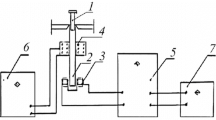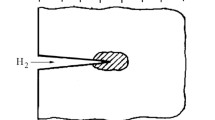Abstract
The mechanical behaviour of small fatigue cracks is investigated for a low, medium and high strength material. At first an elastic consideration is performed which give a good impression how the stress fields change with crack size. In part 2 a full elastic-plastic analysis of short cracks is performed using a new numerical scheme to simulate the growth of shear bands emanating from the crack tip. The influence of material and loading paramters as well as of the crack size on the plastic crack tip opening displacement is discussed. It is also investigated how it is possible to get a conservative estimate of the crack tip deformation at small cracks.
Similar content being viewed by others
References
Anderson, T.L. 1995). Fracture Mechanics: Fundamentals and Applications, Second edition, CRC Press, Florida.
ASTM 813-89. Standard Test Method for J IC. A Measure of Fracture Toughness. ASTM Standards., 1993, Vol. 03.01.
Blackburn, W.S. (1985). Contour integrals around crack tips for reversed loading. International Journal of Fracture 28, R73–78.
Blochwitz, Chr. private communication.
Calon, M.J., Jones, J.W. and Allison, J.E. (2000). Use of small fatigue crack growth analysis in predicting the S-N response of cast aluminum alloys. In Fatigue Crack Growth Thresholds, Endurance Limits and Design, (edited by Newman, J.C. Jr. and Piascik), ASTM STP 1372, West Conshohocken, PA, pp. 285–303.
Davidson, D.L. and Lankford, J. (1986). High resolution techniques for the study of small cracks. Proceedings of Small Fatigue Cracks (edited by Ritchie, R.O. and Lankford, J.), pp. 455–470.
Dowling, N.E. and Begley, J.A. (1976). ASTM STP 590, Am. Soc. Test. Mats., p. 82.
Gangloff, R.P. and Ritchie, R.O. (1985). Environmental effects novel to the propagation of short fatigue cracks. Fundamentals of Deformation and Fracture, Proceedings, Eshelby Memorial Symposium, (edited by Bilby, B.A., Miller, K.J. and Willis, J.R.), pp. 529–558.
Herman, W., Hertzberg, R.W. and Jaccard, R. (1988). A simplified laboratory approach for the prediction of short crack behaviour in engineering structures. Fatigue and Fracture of Engineering Materials and Structures 11, 303–320.
Kfouri, A.P. (1997). Limitation on the use of the stress intensity factor, K, as a fracture parameter in the fatigue propagation of short cracks. Fatigue Fract. Engng Mater. Struct. 20, 1687–1698.
Kitagawa, H. and Takahashi, S. (1976). Applicapility to fracture mechanics to very small cracks or cracks in the early stage. Proceedings, Second International Conference on the Mechanical Behaviour of Materials, American Society of Metals Park, OH, pp. 627–631.
Lardner, R.W. (1974). Mathematical Theory of Dislocations and Fracture, Toronto, University of Toronto Press.
Larson, S.G. and Carlson, A.J. (1973). Influence of non singular stress terms and speciemn geometry on small scale yielding at crack tips in elastic-plastic materials. Journal of the Mechanics and Physics of Solids 21, 263–277.
McClung, R.C. and Davidson, D.L. (1991). High resolution numerical and experimental studies of fatigue cracks. Engineering Fracture Mechanics 39, 113–130.
Miller, K.J. and de los Rios, E.R. (eds.), (1986). The Behaviour of Short Fatigue Cracks, Mechanical Engineering Publishing Ltd., London, U.K.
Miller, K.J. and de los Rios, E.R. (eds.), (1992). Short Fatigue Cracks, Mechanical Engineering Publishing Ltd., London, U.K..
Morris, W.L. (1980). The noncontinuum crack tip deformation behaviour of surface microcracks. Metallurgical Transactions A 11A, 850–851.
Muskhelishvili, N.I. (1953). Some Basic Problems of the Mathematical Theory of Elasticity, P. Noordhoff, Groningen.
Navarro, A. and de los Rios, E.R. (1987). A model for short fatigue crack propagation - an interpretation of the short-long transition. Fatigue Fract. Engng Mater. Struct. 10, 169–186.
Newman, J.C. (1983). A nonlinear fracture mechanics approach to the growth of small cracks. In Behaviour of Short Cracks in Airframe Components, Proceedings 328, 6.1–20.
Obrtlik, K., Polak, J., Hajek, M. and Vasek, A. (1997). Short fatigue crack behaviour in 316 L stainless steel. International Journal of Fatigue 19, 471–475.
Pearson, S. (1975). Initiation of fatigue cracks in commercial Aluminum alloys and the subsequent propagation of very short cracks. Engineering Fracture Mechanics 7, 235–247.
Pippan, R. and Stüwe, H.P. (1986). Fatigue crack growth behaviour in constant amplitude and constant ΔK tests on notched specimens. In EFC6, (edited by Elst, H.C. and Bakker, A.) pp. 1269–1277.
Pook, P.L. (1983). The role of crack growth in metal fatigue. The Metals Society London, p. 101.
Rice, J.R. (1967). Mechanics of crack tip deformation and extension by fatigue. Fatigue Crack Propagation, ASTM STP 415, Am. Soc. Testing Mats., pp. 247–311.
Riemelmoser, F.O. and Pippan, R. (1998). An inclined strip yield model for describing monotonic and cyclic plasticity. Proceedings, ICES 98: Modeling and Simulation Based Engineering II (edited by Atluri, S.N. and O'Donoghue, P.E.), pp. 1456–1461.
Riemelmoser, F.O. and Pippan, R. (1999). Monotonic and cyclic crack tip plasticity modelled as growth of shear bands. Proceedings Plasticity 99, Neat Press, pp. 749–752.
Riemelmoser, F.O. and Pippan, R. (1999). The mechanics of moderately stressed cracks. in press.
Riemelmoser, F.O. and Pippan, R. (1998). Mechanical reasons for plasticity induced crack closure. Fatigue & Fracture of Engineering Materials & Structures 21, 1425–1433.
Riemelmoser, F.O., Pippan, R. and Stüwe, H.P. (1998). An argument for a cycle by cycle propagation of fatigue cracks at small stress intensity ranges. International Acta Materialia 46, 1793–1799.
Riemelmoser, F.O., Pippan, R. and Stüwe, H.P. (1997). A comparison of a discrete and a continuous model for describing cyclic crack tip plasticity. International Journal of Fracture 85, 157–168.
Riemelmoser, F.O., Gumbsch, P. and Pippan, R. (2000). Plastic deformation at short edge cracks under fatigue loading. Engineering Fracture Mechanics 66, 357–374.
Ritchie, R.O. and Lankford, J. (1986). Small fatigue cracks: A statement of the problem and a potential solution. Materials Science and Engineering 84, 11–16.
Ritchie, R.O. and Lankford, J. (eds.), (1986). Small Fatigue Cracks, TMS-AIME, Warrendale, PA.
Ritchie, R.O. (1996). Small cracks and high cycle fatigue. Proceedings of the ASME Aerospace Devision 52, 321–333.
Sih, G.C. (1973). Mechanics of Fracture 1, Methods of Analysis and Solutions of Crack Problems, Noordhoff, Leiden.
Suresh, S. and Ritchie, R.O. (1984). Propagation of Short Fatigue Cracks. International Materials Review 29, 445–476.
Suresh, S. (1998). Fatigue of Materials, Second Edition, Cambridge University Press, Melbourne.
Tabernig, B., Powell, P. and Pippan, R. (2000). Resistance Curves for the threshold of fatigue crack propagation in particle reinforced Aluminum alloys. Proceedings of Fatigue Crack Groth Thresholds, Endurance Limits and Design, ASTM STP 1372, (edited by Newman, J.C. and Piascik, R.S.), pp. 252–265.
Tanaka, K. (1983). The cyclic J-integral as a criterion for fatigue crack growth. International Journal of Fracture 22, 91–104.
Tanaka, K. and Nakai, Y. (1983). Propagation and non-propagation of short fatigue cracks at sharp notches. Fatigue of Engineering Materials and Structures 6, 315–327.
Tanaka, K., Nakai, Y. and Yamashita, M. (1981). Fatigue crack growth threshold of fatigue cracks. International Journal of Fracture 17, 519–533.
Tanaka, K. and Akinawa, Y. (1988). Resistance-curve method for predicting propagation threshold of short fatigue cracks at notches. Engineering Fracture Mechanics 30, 863–876.
Tomkins, B. (1975). The development of fatigue crack propagation models for engineering applications at elevated temperatures. Journal of Engineering and Material Tech. 97H, 289–297.
Zhang, T.Y. and Li, J.C.M. (1991). Image force and shielding effects of an edge dislocation near a finite length crack. Acta Materialia 39, 2739–2744.
Zhang, T.Y. and Li, J.C.M. (1999). Proceedings, International Symposium on Plasticity and its Current Applications, pp. 791–793.
Author information
Authors and Affiliations
Rights and permissions
About this article
Cite this article
Riemelmoser, F.O., Pippan, R. Consideration of the mechanical behaviour of small fatigue cracks. International Journal of Fracture 118, 251–270 (2002). https://doi.org/10.1023/A:1022928722764
Issue Date:
DOI: https://doi.org/10.1023/A:1022928722764




